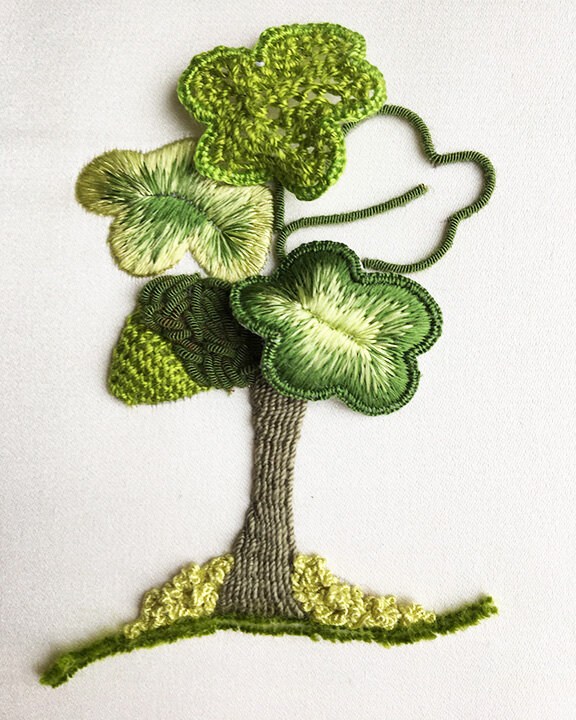
Raised work is a form of three-dimensional embroidery sometimes known as stumpwork. It was a popular form of embroidery in England in the second half of the seventeenth century. Precious items such as trinket boxes and mirrors were covered in raised embroidery. Typical elements include figures, foliage and flowers and animals. Today many of the C17th techniques and materials are still used e.g. wired shapes, needlelaces, which may be padded, and silk wrapped purls. The technique can be used for contemporary as well as traditional images.
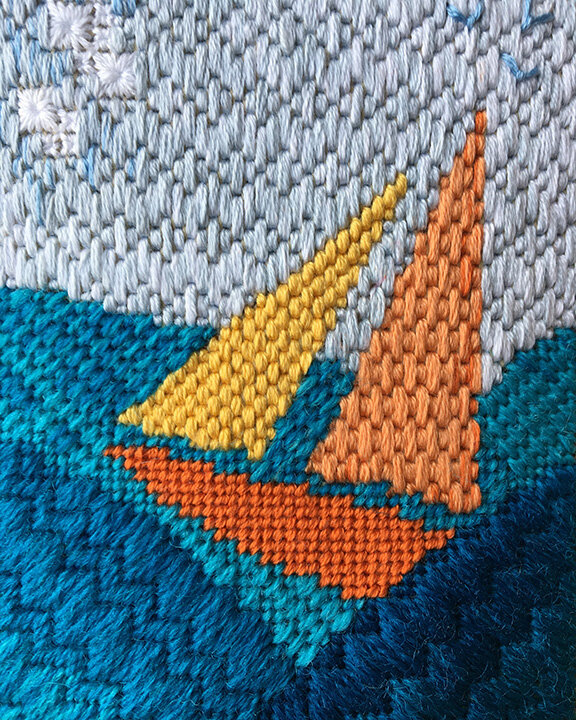
Canvas stitches is a counted embroidery technique typically worked on canvas fabric or even weave fabric. There are a multitude of stitches which can be used varying in scale and texture. An equally varied number of threads can be employed: wool, silk, stranded cottons, synthetics, gold threads etc. Usually there is more than one thread in the needle so there is also a lot of scope for colour shading. With careful planning embroideries with depth and dimension can be created.

Some sources believe that blackwork arrived in England with Catherine of Aragon. It is a counted technique. The traditional version is based on repeat patterns stitched in black thread on white fabric. Many Tudor paintings show examples of court clothing incorporating blackwork embroidery. A contemporary interpretation creates images which incorporate a wide range of tones between absolute white and solid black. This is achieved by using a variety of black threads of different thicknesses and breaking up or filling in the patterns used
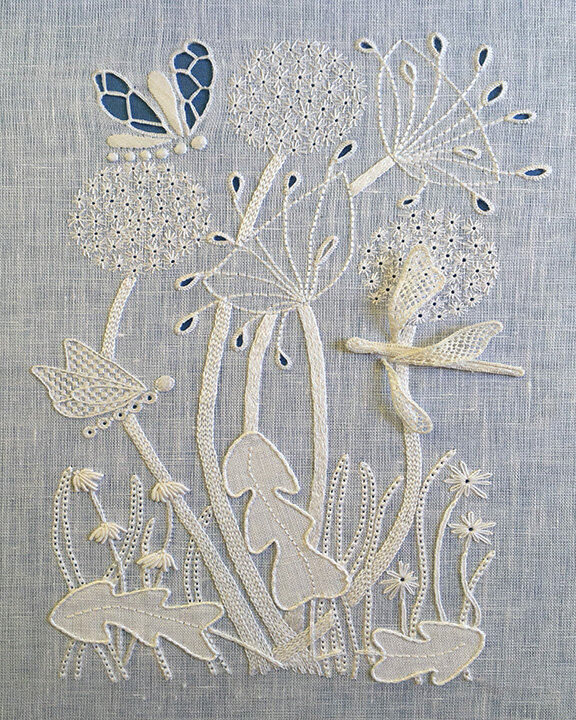
White work is an umbrella term for a lot of different techniques which have in common the use of white threads on white fabric. There are counted techniques such as Pulled Work whereby stitches are pulled tightly to create patterns in the ground fabric and Drawn Work in which some of the ground fabric is removed entirely and the remaining fabric is secured with stitching to make a design. There are Cut Work techniques such a Broderie Anglaise or Richelieu in which the surface fabric is stitched, often using buttonhole stitch. and part of the fabric is then cut away to create the design. There are many other whitework techniques for example see Mountmellick and Shadow Work.

Strictly speaking crewel work simply means embroidery with two ply wool. It is often associated with traditional “Jacobean” designs which include flowers, trees and foliage, animals and hillocks. Typically, the elements are out of scale with each other, such as a large bird on a small tree, which is one of the charms of the work. There is a vast range of stitches which can be used as outlines, as filling stitches, as flat or as textural stitches. All the stitches can equally be used to create contemporary images in wool.

Adding a third dimension adds interest to embroidery. Padding can be formed with many different materials. This is string couched with gimp on the left and chainette on the right.
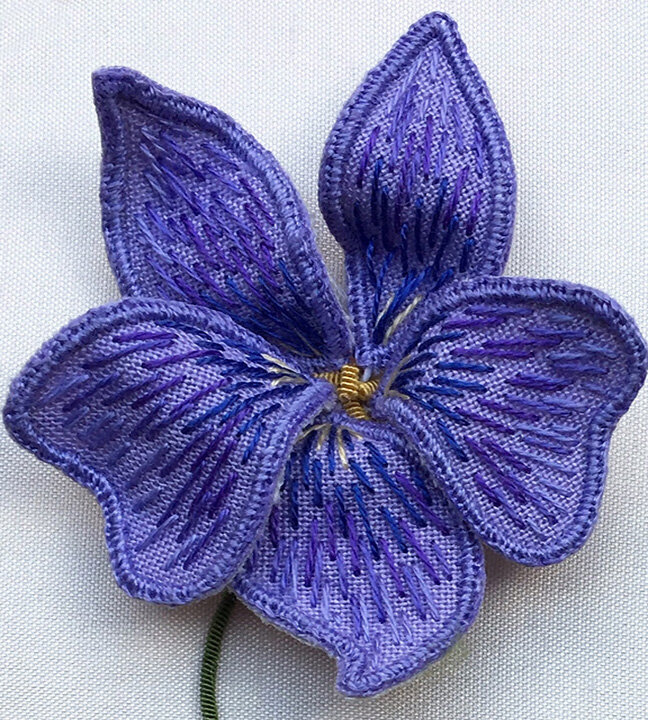
Raised work is a form of three-dimensional embroidery sometimes known as stumpwork. It was a popular form of embroidery in England in the second half of the seventeenth century. Precious items such as trinket boxes and mirrors were covered in raised embroidery. Typical elements include figures, foliage and flowers and animals. Today many of the C17th techniques and materials are still used e.g. wired shapes, needlelaces, which may be padded, and silk wrapped purls. The technique can be used for contemporary as well as traditional images.

A fun way to use up left over materials is to create mini embroideries in the form of big buttons. With a pin at the back the button works as a brooch. Instant present.
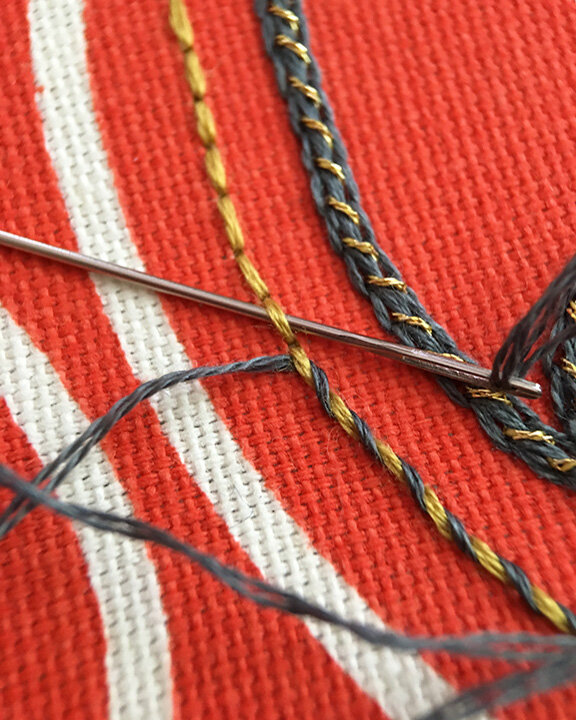
Embroidery does not have to start with a blank canvas. Embellishing patterns on woven or printed fabric can work too. This is back stitch whipped with a different colour and two rows of chain stitch whipped with gold thread.

Inspired by Peruvian textiles - bright colours, floral images - this piece is worked in perle. Stitches include long and short, chain, French knots, bullions, a stacked arrow head, stem stitch and braid stitich.










Raised work is a form of three-dimensional embroidery sometimes known as stumpwork. It was a popular form of embroidery in England in the second half of the seventeenth century. Precious items such as trinket boxes and mirrors were covered in raised embroidery. Typical elements include figures, foliage and flowers and animals. Today many of the C17th techniques and materials are still used e.g. wired shapes, needlelaces, which may be padded, and silk wrapped purls. The technique can be used for contemporary as well as traditional images.
Canvas stitches is a counted embroidery technique typically worked on canvas fabric or even weave fabric. There are a multitude of stitches which can be used varying in scale and texture. An equally varied number of threads can be employed: wool, silk, stranded cottons, synthetics, gold threads etc. Usually there is more than one thread in the needle so there is also a lot of scope for colour shading. With careful planning embroideries with depth and dimension can be created.
Some sources believe that blackwork arrived in England with Catherine of Aragon. It is a counted technique. The traditional version is based on repeat patterns stitched in black thread on white fabric. Many Tudor paintings show examples of court clothing incorporating blackwork embroidery. A contemporary interpretation creates images which incorporate a wide range of tones between absolute white and solid black. This is achieved by using a variety of black threads of different thicknesses and breaking up or filling in the patterns used
White work is an umbrella term for a lot of different techniques which have in common the use of white threads on white fabric. There are counted techniques such as Pulled Work whereby stitches are pulled tightly to create patterns in the ground fabric and Drawn Work in which some of the ground fabric is removed entirely and the remaining fabric is secured with stitching to make a design. There are Cut Work techniques such a Broderie Anglaise or Richelieu in which the surface fabric is stitched, often using buttonhole stitch. and part of the fabric is then cut away to create the design. There are many other whitework techniques for example see Mountmellick and Shadow Work.
Strictly speaking crewel work simply means embroidery with two ply wool. It is often associated with traditional “Jacobean” designs which include flowers, trees and foliage, animals and hillocks. Typically, the elements are out of scale with each other, such as a large bird on a small tree, which is one of the charms of the work. There is a vast range of stitches which can be used as outlines, as filling stitches, as flat or as textural stitches. All the stitches can equally be used to create contemporary images in wool.
Adding a third dimension adds interest to embroidery. Padding can be formed with many different materials. This is string couched with gimp on the left and chainette on the right.
Raised work is a form of three-dimensional embroidery sometimes known as stumpwork. It was a popular form of embroidery in England in the second half of the seventeenth century. Precious items such as trinket boxes and mirrors were covered in raised embroidery. Typical elements include figures, foliage and flowers and animals. Today many of the C17th techniques and materials are still used e.g. wired shapes, needlelaces, which may be padded, and silk wrapped purls. The technique can be used for contemporary as well as traditional images.
A fun way to use up left over materials is to create mini embroideries in the form of big buttons. With a pin at the back the button works as a brooch. Instant present.
Embroidery does not have to start with a blank canvas. Embellishing patterns on woven or printed fabric can work too. This is back stitch whipped with a different colour and two rows of chain stitch whipped with gold thread.
Inspired by Peruvian textiles - bright colours, floral images - this piece is worked in perle. Stitches include long and short, chain, French knots, bullions, a stacked arrow head, stem stitch and braid stitich.